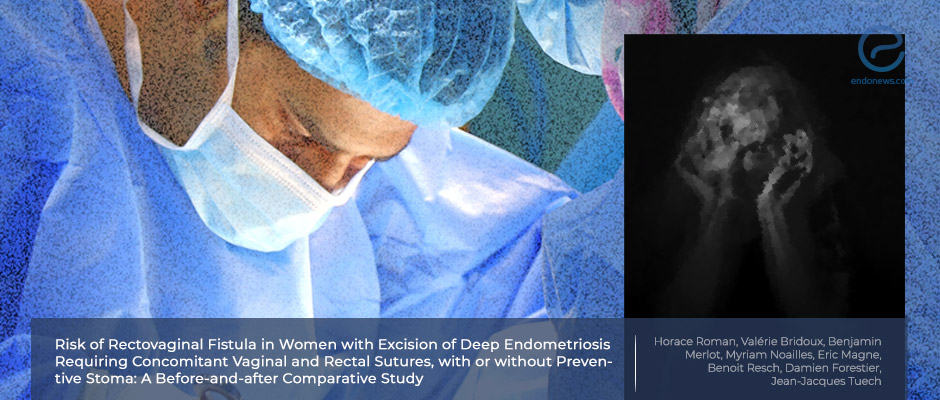Technical Facts for the Prevention of Complications After Deep Endometriosis Surgery
Sep 3, 2021
Preventive stoma does not influence the risk of rectovaginal fistula in women with deep infiltrating endometriosis, study finds.
Key Points
Highlights:
- There seem to be no statistically significant differences in terms of rectovaginal fistula formation risk in women with rectovaginal endometriosis who were managed with a liberal or restrictive preventive stoma approach.
Importance:
- The liberal policy of preventive stoma is not superior to the restrictive preventive stoma approach in terms of rectovaginal fistula formation, however rectal sutures within 8cm to the anal verge increases the occurrence of rectovaginal fistula more than threefold.
What's done here:
- This is a retrospective, before-and-after comparative study from two centers.
- Main purpose was to clarify the benefits of a stoma for preventing the rectovaginal fistula in deep endometriosis surgery.
- The multidisciplinary team surgeons approach to the deep endometriosis surgery involving rectum and vagina was changed after September 2018:
- Before the publication questioning preventive stoma and change of the guidelines, a liberal policy of preventive stoma was adopted.
- From September 2018 centers adopted a more restrictive policy for preventive stoma.
- Standaradized gastrointestinal questionnaries were used to assess the pre- and the postoperative function.
- Patient charactheristics, intraoperative findings during surgeries, postoperative complications were compared and the factors related to the probability of rectovaginal fistula formation were statistically evaluated.
Key results:
- The rate of rectovaginal fistula formation was 9.4% in women who were managed without stoma and 10.1 % in a center that adopted a more restrictive policy of preventive stoma.
- When the women were managed with a stoma, the rate of rectovaginal fistula formation was 10.8% in the liberal center and 7% in the restrictive center.
- The height of the rectal stapled line was significantly lower in women who had a stoma, especially in those managed at the restrictive center.
- Rectal sutures within 8 cm from the anal verge increased the risk of rectovaginal fistula independently from the creation of a stoma, the surgical procedure used, the size of the vaginal infiltration, and the excision of deep infiltrating endometriosis involving the pelvic nerves.
Limitations:
- The study is not randomized meaning that there are women with and without a stoma in each group.
- The techniques used to remove rectal nodules differ between patients and can have an influence on the results.
- Patients at the liberal center were managed before those at the restrictive center and it is likely that the surgeon practicing at both centers had more experience during the second time period.
- The sample size is small and does not allow to reach a conclusion about the risk of fistula whether or not a preventive stroma is performed.
Lay Summary
There are no differences in the risk of rectovaginal fistula in women with rectovaginal endometriosis who were managed by a liberal or restrictive policy of preventive stoma according to a study by French researchers published in the Journal of Minimally Invasive Gynecology.
According to the authors, this result suggests that stomas should not be routinely performed in women with rectal and vaginal sutures. Instead, they should be carefully evaluated based on risk factors such as distance from the anal verge.
A rectovaginal fistula is an abnormal connection between the rectum and the vagina that means that the contents of the bowels can leak into the vagina. It is a major complication following deep endometriosis surgery.
The liberal policy of preventing stoma is the use of a diverting stoma while the restrictive policy is the detection of biologic predictors for fistula or leakage requiring emergency stoma creation beforehand.
In order to assess whether a liberal policy of preventive stoma reduces the rate of rectovaginal fistulas in women with deep infiltrating endometriosis who underwent excision surgery and who required vaginal and rectal sutures, a team of researchers led by Dr.Horace Roman from Endometriosis center of Bordeaux and Denmark, and Dr. Jean-Jacques Tuech of the Department of Digestive Surgery at Rouen University Hospital in France conducted a retrospective before-and-after comparative study.
During the study, they analyzed 363 women with deep endometriosis infiltrating the rectum and the vagina. Of these, 241 underwent surgery with a liberal policy of preventive stoma while 122 underwent surgery after adaptation of a more restrictive policy of preventive stoma. The rate of preventive stomas was 71.4% at liberal policy while it was 30.3% at the restrictive policy center.
Rectovaginal fistulas occurred in 31 patients, 19 of whom were managed by liberal policy and 12 in the restrictive policy center. The rate of rectovaginal fistula formation was 9.4% in women who were managed without stoma, but was 10.8% in women who were managed with a stoma in the same center. In women who were managed in the restrictive policy center, the rate of fistula formation was 10.1% without stoma and 7% with a stoma. The height of the rectal stapled line was significantly lower in women who had a stoma.
The researchers also found that rectal sutures within 8 cm from the anal verge increased the risk of rectovaginal fistula. This was independent of the creation of a stoma, the surgical procedure, the size of the vaginal infiltration, and the excision of deep infiltrating endometriosis involving the pelvic nerves.
The researchers concluded that were no statistically significant differences in terms of risk of fistula formation whether a liberal or more restrictive policy of preventive stoma was adopted. However, more research is needed to confirm these findings, they said.
Research Source: https://pubmed.ncbi.nlm.nih.gov/34175463/
rectovaginal fistula stoma deep infiltrating endometriosis excision surgery

